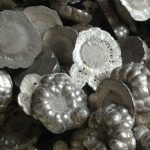Deprecated: get_settings is deprecated since version 2.1.0! Use get_option() instead. in /www/sites/alloy.wiki/index/wp-includes/functions.php on line 4862
Titanium welded pipes generally have the following four processing methods:
- Sheet-pressed welded titanium pipe: Compared with the multi-slit “shrimp” type, this titanium pipeline has fewer welds, but the more complicated the sheeting process is, a large number of molds are required, and more materials and processes are consumed. It will also affect the corrosion resistance, and the appearance is not ideal.
- Multi-welded (commonly known as “shrimp waist” type) titanium pipe: its processing technology is complicated, usually by cutting the pipe into multiple sections of oblique openings, welding or forming multiple sections under the plate, and then rolling and welding. This method has a lot of leftover material at the corners and a large amount of welds. Because the welding seam will greatly reduce the corrosion resistance, it is easy to leak, and the appearance is not good. The inner surface is a folded surface, which increases the transmission resistance of the pipeline and increases the erosion and corrosion of the back, which reduces the life.
- Stamped titanium welded pipe: The appearance of this titanium pipe seems to be the same as that of pushed titanium pipe, but the processing technology is to press the tube blank in the upper punching die. During the forming process, the back of the titanium tube is pulled and forced The back is stretched thin, and the inner pipe wall is compressed and thickened, causing uneven wall thickness or wrinkles. In addition, the back of the titanium pipe is subject to erosion and corrosion during use. The thin back wall is prone to premature damage, which greatly reduces the overall life of the pipeline.
- Casting titanium pipe: Although it is a seamless titanium pipe, the wall thickness (at least 5mm) cannot match the pipe wall thickness (2mm~4mm), which increases the transmission resistance, and the surface finish is poor. The more important thing is that there are internal A large number of defects such as pores caused by manufacturing seriously affect the corrosion resistance and life.
The above several kinds of titanium tubes are far from meeting the current requirements, and the advent of the push titanium tube is quickly accepted and welcomed by users because the push titanium tube has its own characteristics.
Titanium welded pipe is processed with seamless titanium pipe as the blank, and the blank with the diameter of the finished product is pushed and extruded on the special pushing extruder. During the forming process, the pipe blank expands. Stress analysis shows that the stress in different parts is different, but under two-way compression, that is, axial compression, radial compression and circumferential tension, the stress is always in a state of tension.
Link to this article:Four kinds of processing methods of titanium welded pipe
Reprint Statement: If there are no special instructions, all articles on this site are original. Please indicate the source for reprinting:Alloy Wiki,thanks!^^


